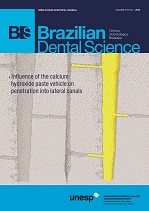Comparative analysis of different prophylatic methods on primary teeth enamel roughness
DOI:
https://doi.org/10.14295/bds.2018.v21i3.1567Resumo
Objective: The purpose of this study was to perform an experimental quantitative comparison of primary teeth enamel alterations under three commonly prophylaxis surface polishing treatments. Material and Methods: 36 healthy primary teeth naturally exfoliated were selected and randomly separated in three groups. Group I was treated with a rotary instrument set at a low speed, rubber cup and a mixture of water and pumice; group II with a rotary instrument set at a low speed, rubber cup and prophylaxis paste Herjos-F (Vigodent S/A Indústria e Comércio, Rio de Janeiro, Brazil); and group III with sodium bicarbonate spray Profi II Ceramic (Dabi Atlante Indústrias Médico Odontológicas Ltda, Ribeirão Preto, Brazil). All procedures were performed by the same operator for ten seconds, and samples were rinsed and stored in distilled water. Pre-and post-treatment surface evaluation was completed using a surface profilometer Mitutoyo SJ400. Results: The results of this study were statistically analyzed with the GraphPad PRISM (version 6, 2010). The pumice and water led to significantly rougher surfaces than other groups in Tukey’s test (Group I: 1.22 Ra; Group II 0.38 Ra; Group III: 1.01 Ra). Pre-and post-treatment comparison revealed significantly rougher enamel surface with pumice. Conclusion: Based on this study, it can be concluded that there was an increased enamel surface roughness when teeth were treated with pumice and water in comparison to bicarbonate spray and prophylaxis paste.
Keywords
Dental enamel; Dental prophylaxis; Jet abrasive system; Enamel roughness; Primary teeth.
Downloads
Downloads
Publicado
Como Citar
Edição
Seção
Licença
TRANSFERÊNCIA DE DIREITOS AUTORAIS E DECLARAÇÃO DE RESPONSABILIDADE
Toda a propriedade de direitos autorais do artigo "____________________________________________________________________" é transferido do autor(es) para a CIÊNCIA ODONTOLÓGICA BRASILEIRA, no caso do trabalho ser publicado. O artigo não foi publicado em outro lugar e não foi submetido simultaneamente para publicação em outra revista.
Vimos por meio deste, atestar que trabalho é original e não apresenta dados manipulados, fraude ou plágio. Fizemos contribuição científica significativa para o estudo e estamos cientes dos dados apresentados e de acordo com a versão final do artigo. Assumimos total responsabilidade pelos aspectos éticos do estudo.
Este texto deve ser impresso e assinado por todos os autores. A versão digitalizada deverá ser apresentada como arquivo suplementar durante o processo de submissão.




























